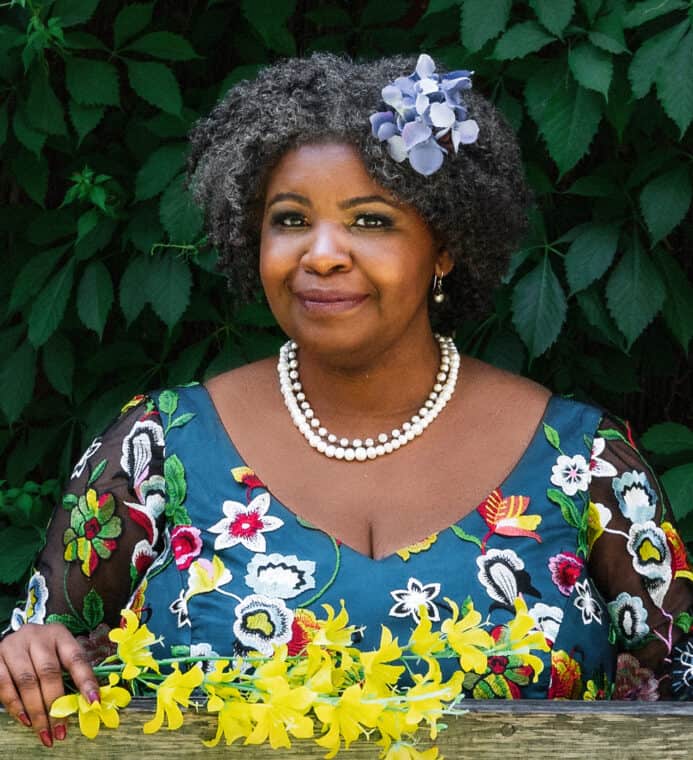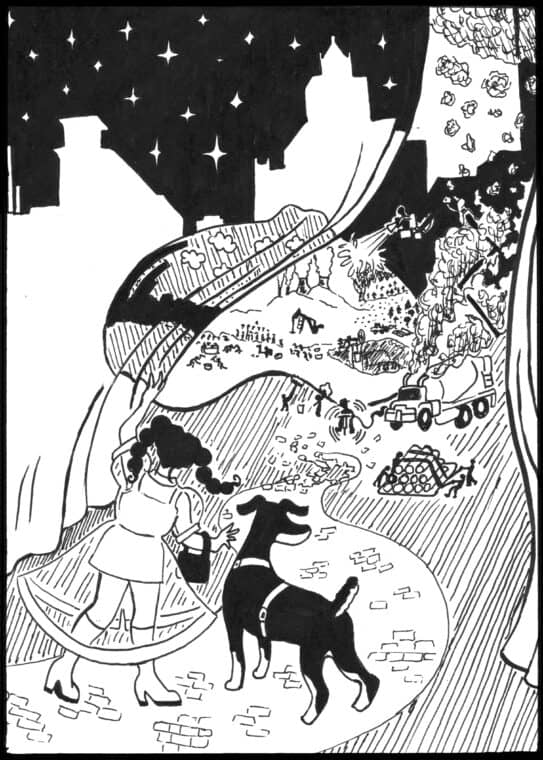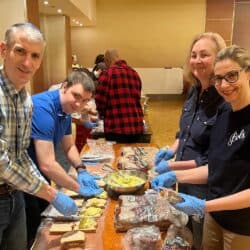Dori Tunstall’s Decolonizing Design is a powerful exploration of the colonial, white-supremacist thrust of modern Western design and technology. Contributor Andrea Gunraj recently spoke to Tunstall, dean at the Faculty of Design at OCAD University, about her book, the work of reconciliation and making amends, and dismantling colonial systems by breaking the addiction to privilege.
Decolonizing Design: A Cultural Justice Guidebook, by Elizabeth (Dori) Tunstall. The MIT Press, 2023; 136 pp; ISBN 9780262047692.
Weaving practical case studies and personal stories into historical and cultural analysis, Elizabeth (Dori) Tunstall’s Decolonizing Design reveals how we can break through and centre Indigenous ways of knowing and doing in our design projects and designing institutions with liberating anti-racist passion.
Reading this short, unique book, I found myself moved in ways I didn’t anticipate. It’s partly because of the scope of the writing. Tunstall pulls together insights and histories across time and place in a way that got my brain buzzing. I’ve taken her wisdom to heart in my own work and life – something easy to do when you see your heart reflected in what you’re reading.
I had the pleasure and privilege of talking to her recently on behalf of The Philanthropist Journal. The following has been edited for length and clarity.

I appreciate how you start your book by speaking to land and your relations. Can we start with that?
I’m here in Tkaronto, the traditional territories of the Mississaugas of the Credit, the Haudenosaunee, the Anishinabek – the custodians of the land for thousands and thousands and thousands of years. We are in treaty land, specifically Treaty 13 and the Treaty of the Dish with One Spoon, and we also have to recognize that many Indigenous communities have made this their home. We also recognize the Métis, the Inuit, other First Nations, and global Indigenous people that live here.
Who am I? I am Dori Tunstall, daughter of Theresa and Joseph, daughter of Raymond and Leatha, granddaughter of Dolores and Johnny, great-granddaughter of Bettie, great-granddaughter of Katrina Raymond, descendant of other ancestors known and unknown. I was born in Columbia, South Carolina, lands of the Catawba, Pee Dee, Chicora, Edisto, Santee, Yamassee, and Chicora-Waccamaw nations. I grew up in Indianapolis, Indiana, on the lands of the Kiikaapoi, Kaskaskia, and Myaamia nations.
I’m African American. Which becomes really emphasized in the context of Canada, especially here in Tkaronto, where many Black people are first or second generation from the Caribbean or from Africa, though there are multigenerational Black Canadians here, too. It creates a different relationship to place and possibilities of racial justice, social justice, and recognition of indigeneity.
The thing I try to emphasize is that African American culture is a hybrid, the culmination of Indigenous cultures, African cultures, and European cultures together, a whole new culture which is distinct and over 400 years old. I’m deeply embedded in that cultural community and all the messiness of that history and what it means.
Thank you for contextualizing. I am in Tkaronto today, too. My background? Well, your book acknowledges indentureship as an under-known history. I appreciate that. My family traces our lines before being settlers on this land to Guyana, South America, long home to many Amazonian Indigenous nations, and before that, to India. Sometimes, I fail to articulate our migrations, our twice-removed dynamics. The question of what happened on a boat and the lost history before that boat is one many of us share. I felt it vividly as you shared how you strive to “put Indigenous first.” You’re transparent about mistakes you’ve made in the process, and you focus on making amends. I love how concrete you are.
The processes of truth and reconciliation here are the outlines by which Indigenous people said, “These are the ways in which you can make amends,” right? These are the 94 ways. And if you’re serious about decolonization, then the work you’re doing is the work of making amends. Part of that is understanding what you did wrong and listening to that. But it’s not as if Indigenous Peoples or other peoples have been inarticulate about the wrongs. The problem is making amends, and the contemporary hurt. We’re not out of the colonization, and the work to make amends is still not fully being done.
If you’re serious about decolonization, then the work you’re doing is the work of making amends.
Part of what this book is about is the way in which an institution is inching its ways towards making amends. But if we – colonial institutions and people who maintain addiction to the privileges of white supremacy, patriarchy, capitalism, and religious bigotry – shifted the framework from exploitation and extraction to making amends, this work wouldn’t have to be done.
I also have a sense that amend-making has to happen on an individual level that crosses over to a mass cultural level.
Tell me more about the crossover.
Know thyself, know who you are, because it’s your disconnection from who you are that’s the source of harmful behaviour you’re manifesting in the world. Knowing who you are, knowing what bits of history you have access to, provides you with context. It’s not like you have to be a historian. History just provides you with context so you can understand how present decisions you make affect the future.
And if we’re all people of the land, then we need to think about where we’re from, because those things, those places, affect us. That’s always the first step. That’s why I was keen on writing a strong narrative stream about myself, showing you, the reader, the work I’ve done to understand who I am.
As you talked about in your own introduction, there’s gaps in our understanding of our ancestors. Most of the time, those gaps speak to the unspeakable. Where you find silence in families is where you find some sort of trauma.
For an institution? On a basic level, an institution is a community. Just a group of people that share similarities. Maybe the similarities are not that deep – like, everyone converts oxygen to carbon dioxide. But it could also be much more than that, and in an institution, people can be in community for multiple generations.
Design becomes the way a community articulates who it is and who it wants to avoid.
This is where design becomes important: design has always been the tool we use to mark who we are. Whether it’s marking our bodies or choosing the clothes we wear, design is what we use to define and display our social position. Design becomes the way a community articulates who it is and who it wants to avoid. Institutions are the space where groups of people use design to create rules of engagement to allow different processes to happen.
Why do we spend so much time and money on branding so an institution can articulate who it is, what it’s about, its mission, vision, objectives? We do this purpose-building in congress with others, and design mediates all of it.
I read a review where the reviewer said you blend theory with memoir in this book. I found it an interesting way of putting it. If your book is memoir, then I suppose all of life is memoir. We carry it in our bodies and institutions, whether we’re conscious of it or not. This brings me to your exploration of Bauhaus, that influential design movement – you unveil the thing we take for granted as “good taste.” I mean, 2019 was declared Bauhaus’s centenary year. We’re still celebrating it.
The European modernist project is the story we’re told that design is something that happened in Europe in the 1800s, and what it was trying to achieve was progress through technology. By progress, what they meant was a better life for the middle and working classes, making their lives more akin to the European aristocracy.
The other element of it is that Europe is a place of thousands of years of intense conflict. The modernist project was about getting rid of ethnic markers of Italianism, Germanism, and the like to join a “universal humankind” in a harmonious relationship. That’s the mythology. Europe is still in conflict. And technology, the Industrial Revolution, was extremely harmful to the peasant class. It’s only in leaving Europe and coming to places like Canada, the United States, and Argentina that that group began to get their better life.
For those in Europe, the better life came when everyone was putting money back into Europe to rebuild it after the war. The Industrial Revolution was beneficial mostly to national aristocratic institutions, not to people, and definitely not to those outside of Europe, living in places that were considered the spoils of Europe’s wars with accelerated extraction and intensified conflict.
This is where the Bauhaus comes in. It’s a response to mechanization at the end of the First World War, where you have a generation of war-broken European men. Bauhaus said, “If we design things for these spiritually and physically broken men, we can rebuild them. Let’s create simplified architecture we can call ‘universally human.’” It won’t have ethnic markers – ethnic markers remind them of the wars. Let’s focus on universal shapes: triangles, circles, squares. No one’s fighting over that. Let’s build efficiency into it and produce a lot of it so it’s affordable, because labour is expensive. The more we mechanize it, the more we can produce for broken European men.
The Bauhaus designers were connected to powerful institutions, which said this model is what we all should aspire to.
This was so revolutionary that they kicked Bauhaus designers out of Europe. The Bauhaus vision was threatening to the Nazi regime. A bunch of the designers went to the United States. When I lived in Chicago, I witnessed the New Bauhaus there, firsthand. Other designers went to West Virginia, others went to Brazil, others went to India. Bauhaus went diasporic. And the designers were connected to powerful institutions, which said this model is what we all should aspire to. In a world as diverse as it is, all of a sudden we’re supposed to aspire to an aesthetic for broken European men. We’ve all been told through magazines, media, and giant art exhibitions at MoMA that this is what we’re to aspire to.

The design field is still 70% white and, depending on where you are, heavily male. You’re supposed to aspire to Bauhaus, which means you cannot be who you are. You can’t bring yourself into that exchange. If you come from a tradition of great making, you enter into the design field thinking, “What my parents, grandparents, great-grandparents were making is craft, kitschy trash that I have to let go of to be this modern person, postmodern person, or post-postmodern person.”
Bauhaus’s aspiration to help broken white men – you give us an empathetic lens here. But you show how good intentions can be infused with white-supremacist logic at the same time. We hear lots about what Indigenous, Black, and racialized people need to do with our trauma and pain. You touch on what white people need to do about their trauma, pain, and power addictions.
The work of decolonization is the work of white folks. They are the ones who put those systems in place. They’re the ones who have to dismantle them. And what’s necessary to dismantle them is to get over their addiction to the privileges of white supremacy. In America, the deliberateness of modernist design created a separation in the solidarity that in some ways existed between exploited white folks, freed Black folks, and Indigenous folks. They literally had to create laws to break that solidarity. They pushed Black and Indigenous people so far down that white people didn’t want to be down there.
The work of decolonization is the work of white folks. They are the ones who put those systems in place. They’re the ones who have to dismantle them.
White people haven’t fully dealt with their historical trauma. Game of Thrones is not fictional in terms of the cruelty inflicted by the aristocratic class. It was so trauma-inducing that people had to flee, with a low chance they’d survive the trip, just to build a better life somewhere else. I read Dickens as a horror story. This is people doing bad things to their own people. They have to unpack the trauma and harm they both faced and inflicted so they could build their better life on the bones and blood of other people.
It can’t be good for your DNA, let alone your soul. Similar to your broken-men lens on Western design, I appreciate your framing of technology as bad romance, with master/slave built into the setup.
After getting my PhD from Stanford, I went into high-tech consulting in the Bay Area in the height of the dot-com era. I was excited to figure out this newfangled thing called the internet and what this technology could mean for people.
I’m ambivalent about technology now. It boils down to calculators. The faster they calculate, the more efficient things are. And that could be great, like if we were delivering medicines in more efficient ways. Human behaviours we’ve imported through technology, making them faster and easier, can be a positive thing. But my ambivalence is about the consciousness of this technology: the world being imagined, the discussions of those who create wealth through technology. I don’t care how you do it – if you accumulated wealth, you’ve been able to do so from extraction of excess labour or water or land. It’s the way things are; capitalism makes it work. You do it in aristocratic mode, with extraction.
Remember, colonization was about the second and third sons who wanted the wealth that the first son would normally inherit. They made money from technologies with the underlying consciousness of “How can we get technology to do what we don’t want to pay people to do?” Those who commercialized technologies did so to be the king or queen. What is a king or queen? You rule people to do things you don’t want to do. And you don’t have to feel empathy for the machine.
“Siri, turn on the light.” “Siri, take me to this.” “Siri, arrange for my laundry to be picked up.” If you were a wealthy person, you would have had human beings to do these things. You would stay wealthy because you didn’t have to pay them wages.
There’s nothing wrong with the technology itself. It’s the underlying consciousness in terms of what our technology is meant to do. What if technology is meant to liberate us to create conditions of joy? What would the design criteria be?
The sheer invisibility of this stuff – I’m thinking about the language of branding. Ruben Pater’s book speaks to branding bodies as a practice of the Dutch West India Company, one of the first corporations with stakeholders and a leader in the transatlantic slave trade. They had brand guidelines on how to do this from back when they started in the 1600s. When I speak branding in my job now, I try to be conscious of this forgotten, harrowing history. And look at how we talk about “the cloud.” We act as if it’s floating in the air and not land-based technology.
I was doing research to try to find the person who branded the cloud. It was the most devious thing to describe the great appropriation of land and water it takes to run data centres. It becomes a justification for tech companies’ stealing swaths of land in desert areas of California, fertile land in Montana, even in places in Canada. It makes it more difficult to reappropriate land back to Indigenous people. How do you get that back when it’s passed through 17 hands?
You’ve been too generous with your time. I just need to ask one more thing. My eye was attracted to the section you wrote on what you call the “supertoken” in institutions, those you hire on who give a veneer of diversity but not inclusion and certainly not decolonization. What advice would you give to the supertoken – maybe the reforming supertoken? And how about the supertokenizer? Asking for a friend.
Understand your role as a path-breaker. You’re there to break the path so that it’s easier for others to travel and follow. That means that when the institution tries to hold you up as an impossible standard, you’re like, “Nope. Let me change the standard and help break the path for others.”
If you’re there with the mentality of “Oh well, it was difficult for me – let other people suffer too,” change that mentality. Your purpose of being is to break the path.
Now, for those looking to hire supertokens, well, it’s great to have them because they’re often the brightest people, right? Please understand that their brightness comes from surviving the gauntlet of systems set up to destroy them.
You might think the reward is to give them the job. But if you’re saying as an institution that you’re into diversity and inclusion and, dare we say, decolonization, bringing them in is not creating a new standard. You’ve just brought in a person who exceeds your standards.
So, yes, bring them in, but bring them in as path-breakers. When they try to bring in others, get out of their way. Understand that you can best support them by building a community around them, with multiple generations. They need elders who can guide them. They need those just beginning in their steps to be able to follow through. And the community needs to be at a critical mass so they don’t get swept away by the culture of the organization.

